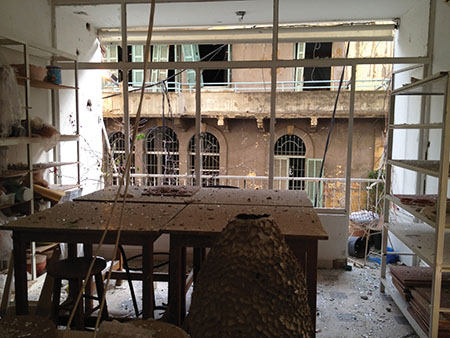Everything & Nothing
On working as an artist in Beirut today
On working as an artist in Beirut today

‘The kilns are still working. The wheels I have to test. I think they’re ok and we don’t need more. In three weeks I think we’ll be ready to start in the new place.’ I’m stepping through the wreckage of Nathalie Khayat’s studio, listening to her and wondering, ‘What madness is this?’ It’s the end of October and just 12 days have passed since a 30-kilogram car bomb ripped through the building in Beirut where Khayat lives and works (no one has claimed responsibility but the Syrian regime has been widely accused). The explosion killed eight people, including the Lebanese intelligence chief Wissam al-Hassan, and wounded more than 80. What’s left of Khayat’s studio sits just above the blast site. Every pane of glass has been shattered or reduced to fine powder. I lean over the balcony railing and see the charred carcass of an upturned car half-covered in blue tarpaulin and police tape. I turn back into the studio and see the half-smashed face of a wall clock stopped at 2.40pm. After a character in Don DeLillo’s novel Mao ii (1991), I resist the urge to tell Khayat that her clock must have been running ten minutes slow.
This particular bomb – the latest in a long and sorry string of targeted assassinations that began, in 2005, with the murder of Lebanon’s former prime minister, Rafik Hariri – went off at 2.50pm. At the time, Khayat was sitting at home reading with her nine-year-old son Teo. It was only because they had their backs to the windows that neither of them caught any glass in their faces, just the backs of their heads, necks, arms and shoulders. Shards of glass struck the far walls like daggers. Khayat and Teo are still finding glass under their skin; the day before my visit, Khayat had staples removed from her back.
Khayat – who has staged two solo exhibitions in the last year alone, has been teaching ceramics since 1999, and looks after a studio that serves as a sanctuary for more than 40 current and former students – lost decades’ worth of delicate porcelain vessels in the blast. In a way, though, she lost everything and nothing.
‘I lost all the things I care for in terms of objects,’ she explains. ‘All of my own pottery, what I had gathered from friends, what I had bought, what mattered to me. What’s left is very easy to throw away. I feel light,’ she says, then pauses. ‘I feel lighter. My way of resisting this definitely goes through my work. I’m not going to drown. I’ve been through many things but never as close as this. I’m full of questions and I’m still in shock. Many times in my work I’ve questioned what I do. It seems absurd in times like this. But this is all I can do. It keeps me going. And I love what I do.’
Khayat’s story would be tragic but also typical – how many works have been lost in the history of Lebanese art? – were it not for the fact that somewhere in between survival and aftermath, Khayat found herself a new studio. Moreover, with the help of her students and a slew of volunteers, she packed up, moved in and continued working.
To follow the story of Beirut’s artists over the past decade has been to follow them far too often through a landscape of physical and psychological destruction. In the last chapter of Mao II, DeLillo writes of the stories a character hears in Beirut: ‘Isn’t there supposed to be an irony, some grim humour, some sense of the peculiar human insistence on seeing past the larger madness into small and skewed practicalities, into off-shaded moments that help us consider a narrow hope? [...] She has come here already tired of these stories [...] They’re all the same and all true and it is sad that they are necessary.’
On the afternoon of the bombing I had scheduled a studio visit. I emailed the artist and asked: ‘Do you want to postpone?’ He replied: ‘No, I’m here.’ We met and talked distractedly for hours. Finally, he told me his niece went to school next to Khayat’s building. It was a close call. ‘My parents would have killed themselves if something had happened to her,’ he said suddenly, urgently, as we said goodbye. The way back to my neighbourhood was blocked by a mob of angry men burning tyres. I sent the artist a message: ‘You get home okay?’ ‘Fine,’ he said. ‘You?’ From a car sliding the wrong way down an exit ramp to avoid the mayhem, I wrote: ‘Totally fine, taking a small tour.’ We have all learned forms of madness, denial and amnesia here. As phenomena go, the wrecked studio has become disturbingly normal, repeated and expected.
Still, for Khayat to carry on is not only a narrow hope for Beirut but a stunning example for us all of what art can do in the face of disasters both natural and man-made. She has a show lined up in February. Three of the pieces she had made for it were effectively liquefied. ‘It’s ok,’ she says, pushing her glasses up the bridge of her nose and smiling. ‘I still have my hands. And clay is really nothing. We can do a lot here with nothing.’
























